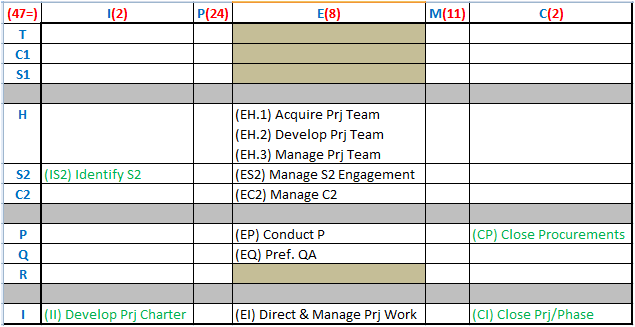Do you get confused in picking the right KA or PG for a given activity name or vice versa?
Do you get confused about how many processes per PG or KA?
Do you feel memorizing the Process Chart might help you?
Do you feel remembering the sequence of process could have helped you in some way?
Actually memorizing the process chart is not helpful in any of these as the headache of memorizing and heartbeats of recalling are not worth above questions...and with some days of studies you'll automatically get used to all of them.
If you still face issues, this post is for you...
Have you gone through below post for some other types of answers on verbs (PG) and nouns (KA)
We will extend similar shortcuts here and there are multiple references to above link.
Below is Kim's PG sequencing diagram -
As the Diagram says, the processes in 5 PG's have a proper sequence (1 to 4, green arrows and numbering)
But what if something is not made/built/implemented i.e. "E" as planned i.e. "P"? We will find out about such misses in "M" and need to return to "E" from there instead of closing "C". Hence the arrow 5
e.g.:- Perf. QA is an "E" process that's carried out before and after Control Q which is an "M" process.
So QA to QC arrow 3 and QC to QA arrow 5
What if Plan itself needs to be carried out once again? Plan could also be faulty or something was missed to be Planed and hence to be implemented subsequently? We will again find this out in "M" and the completed process will start from "P" this time. Hence the arrow 6.
e.g.:- An approved CR might require planning again so might follow arrow 6.
First time right deliverable will follow arrows 2-3-4 only.
Creating process chart in 7 steps-
*****************************
(This method will require 1-2 time revision to be able to draw it on ur own)As we will study PG-wise, and #PG < #KA, its easier to draw..
Can you simply list out the PG's in columns and KA's in rows.. (sequence is given at link mentioned above)
PG seq - I,P,E,M,C
KA seq - TC1S1, HS2C2, PQR, I
(This KA sequence will also help in some internal sequencing you ll come across, so better don't divert from this one)
By now, you must be knowing there are total 47 process across 5 PG's (and 10 KA's but we are concentrating on PG-wise distribution)
So how many processes per PG?
2-2 in I and C (first and last PG's)
(2*2*2=) 8 in E (i.e. in middle PG)
('1'||'1'=11) in M
(8*3 =) 24 in P
Can you try to put the numbers like this by just remembering above description?
(Hope you still remember verbs and noun funda mentioned in above link)
For sequencing 47 processes we used format
<PG><KA>[.#]
I and C -
Just remember (2*2 =) 4 process names and place them against their KA's
Id (Identify) Stakeholder
Develop Prj Charter
Close Procurement
Close Prj or Phase
Don't take Risk of Executing TCS cuz of HR++
i.e. no R,T,C1,S1..means we have (10-4=) 6 KA's under column "E"
So please cross (or color) the boxes where you are not putting any process names.
As we know E has 8 processes cuz of double pluses in HR -
Now please put the numbering (in brackets) first..and then start writing the names -
Signature verb of this PG is Manage, (Direct & )Manage..
So you need to remember only these verbs -
H is "Acquired" (this verb is used only here in "E") and "Developed" (this verb is in "I" and "P" as well) both.
Procurement is "Conducted" (this verb is used only here in "E")
QA is "Performed" (perf. verb has been used in M as well once)
Do u also notice an "Engagement" after S2, it happens in "M" as well
M -
Signature verb of this PG is Control, M (Monitor & Control)..
Each KA is Monitored except H, cuz H had enough (++) in E already.
Lets color its box and don't put anything made-up of imagination here ;-P
So we should have (10-1=)9 processes in M whereas we have 11.
i.e. I and S1 both have an additional processes making (9+2=) 11 processes in "M"
Those 2 additional ones are very imp too-
Validate S1 - (brings the Deliverable)
Perf. ICC - Integrated Change Control (digests the CR's to work upon)
Did you notice "Schedule" noun for "Time".
Remember no option with noun-"Time" or verb "Execute" is correct in exam.
What comes to your mind first when you hear "Time management" or "Execution" :? Nothing related to PMP, right?
P -
Now remains the biggest task
Distributing 24 among 10 KA's is difficult.
Lets distribute with partiality in this sequence and weightage -
This time take the Risk of doing so for TCS -
i.e. R-5,T-6,C-3,S-4. Just remember this as is
and number the sequences in the boxes
Name 1st processes in each KA as -
Plan <KA> Management.
Only for Time, KA is replaced with noun - Schedule
Now recall the nouns (and unique verbs) under each KA and don't forget the sequence of processes within the P PG -
Like for PC1.# -
First Costs of Activities are Estimated and then overall Budgeting is done.
Also notice that the big colored boxes are not double in any row?
That's cuz if one KA has multiple processes in a PG, then it either skips some of the other PG's or has only 1 processes in other PG's
Also when u c a shortcut, do u read the full name? I do.
Can u try making this chart by urself once while reading and 2nd time by recalling the steps..third time u can do it on ur own.







